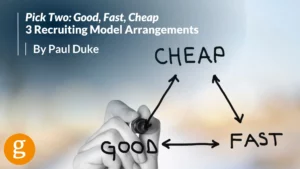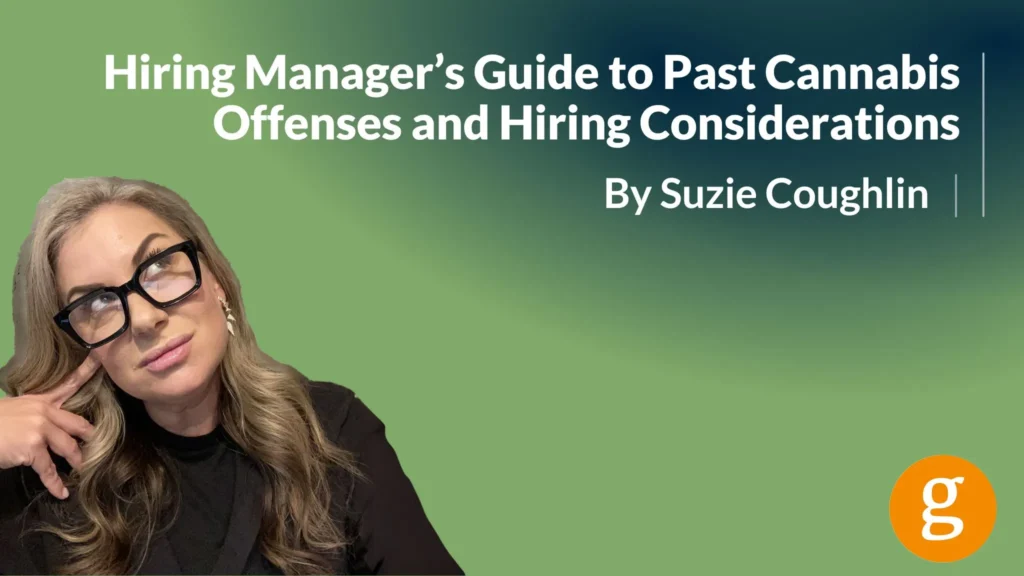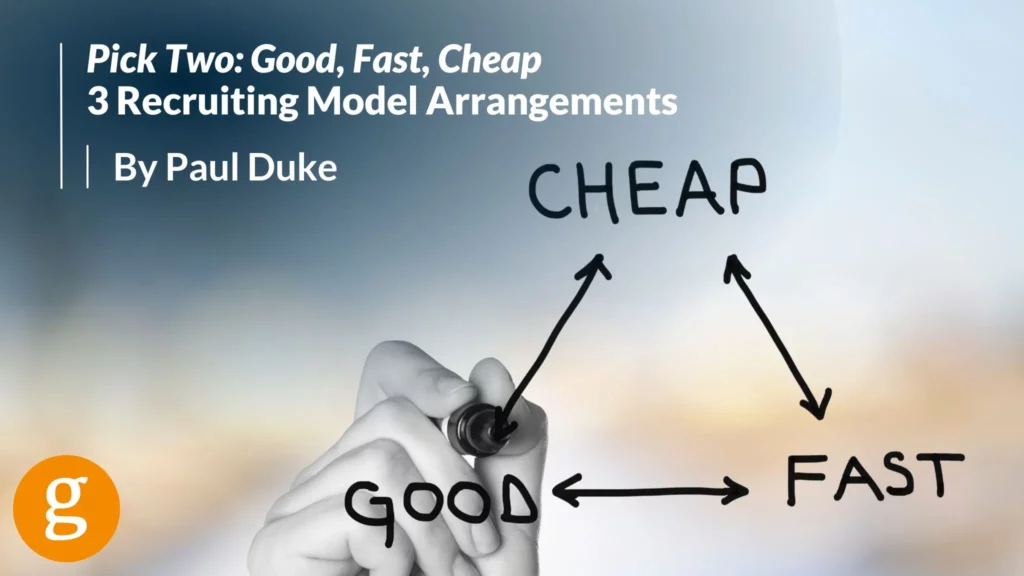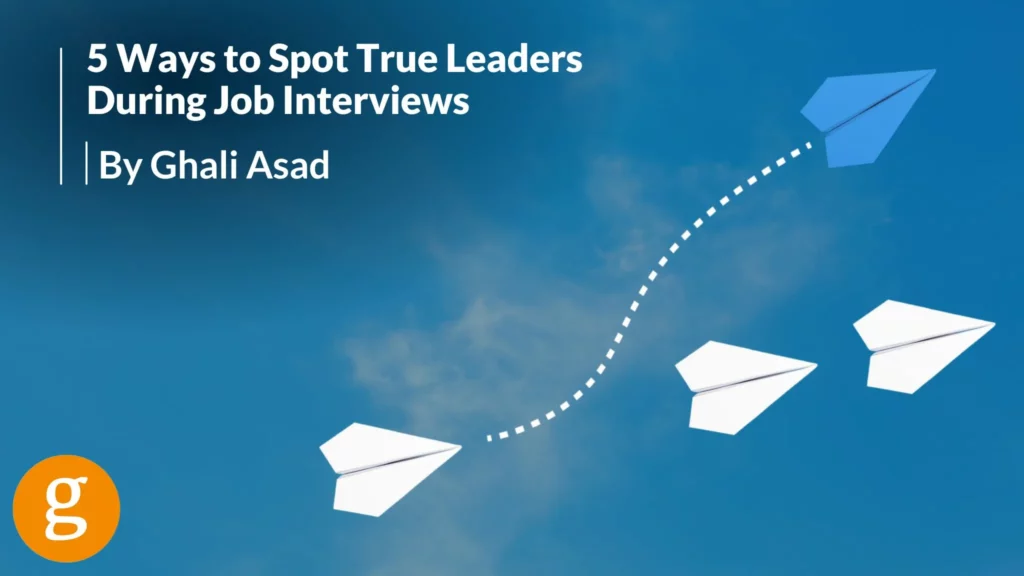Pick Two: Good, Fast, Cheap – 3 Recruiting Model Arrangements

The classic engineering and manufacturing maxim known as the Project Management Triangle (also known as the iron triangle) is an effective way to view talent recruiting arrangements and outcomes.
The maxim states, “Pick Two: Good, Fast, Cheap.” So, for any project that is undertaken, the concept emphasizes that you can only optimize two of the three constraints, while the third is a trade-off.
When it comes to talent recruitment, which two of the triple constraints are most important to you? Here’s a breakdown, including the pros and cons of each.
1. Fast and Cheap
If you’re pressed for time or have a tight budget, you’ll find that quality is hard to come by. Fast and cheap talent recruitment is often rushed and the results are typically poor quality.
- Talent recruiting service providers that specialize in this type of work are known as “resume mills.” Often, job candidates are not vetted by the recruiter or informed of opportunities for which they may be considered. In recruiting, this adage says it best: “Just throw some spaghetti against the wall and see what sticks!”
- This type of recruiting arrangement is like a basic model of a car or house, and won’t come with added features or customizations.
- If you don’t have your own resume sourcing licenses, such as LinkedIn Recruiter, ZipRecruiter, Indeed, etc., and you just need access to a filtered pool of potential candidate resumes to review for yourself, this is likely the best option for you.
2. Fast and Good
If money isn’t as much of a concern, you can invest in high-quality work that is quickly performed by a talent recruiting firm.
- With many searches and priorities competing for their time and attention, a talent recruiter is often only able and willing to commit full effort to an urgent new search if it is done on a retained or exclusive basis. This commitment by the client and recruiter comes with an appropriate return on the client’s investment.
- In a retained search model, the estimated placement fee is split into halves or thirds. For example, the recruiter receives one third of the fee up front from the client, then another third after the client’s chosen candidate is selected and accepts the job offer, and the final third is paid when the candidate starts their new role.
- In an exclusive arrangement, even without advance payment, if placement of a candidate is guaranteed by the recruiter, concierge-level services can be unlocked. These may include highly customized and deep-level interviewing, taking ownership of the entire recruitment process to ensure all internal and external candidates are consistently and thoroughly vetted, candidate testing, more extensive reference-gathering, and other services that mitigate hiring risks.
- While retained and exclusive options typically come with a higher price tag, especially for highly specialized roles, it is important to note the benefits. If you are willing to enter into a retained/exclusive agreement in which your recruiter is guaranteed to make a placement in a reasonably short amount of time, the project agreement terms can be very negotiable. This may include lower fees or longer placement guarantee periods.
3. Good and Cheap
Good things come to those who wait, and if you aren’t rushed for time, this may be the right option for you.
- The average corporate talent recruiter is working 30 to 40 open roles, or search requisitions, at any given time. More specialized agencies that handle niche positions might work half of that, or 15 to 20 at a time. Boutique and executive search firms might only focus on five to 10 high-level roles at a time. Typically the lower volume worked, the higher fees.
- Depending on your chosen recruiter’s makeup, experience, working style, available resources, and team size, as well as the varying complexities of the open roles they are filling, and how many of those roles are “resume mill” or “retained/exclusive” type searches – your new talent need is competing for a fraction of your recruiter’s available time.
- Talent searches conducted in good and cheap mode lean more into a “gatherer” mentality, rather than a “hunter” mentality. Searches are built and candidates are scanned regularly, but deep-dive work and direct recruiting may not be happening to their fullest potential. This is like fishing with a net and seeing what you get, rather than using specific lure-and-cast strategies to target exactly what you want.
- This option is best when you and your team members have time to make the best possible decision, rather than rushing to backfill a position or put out a fire.
Which two will you choose?
For scenarios #2 and #3 above, a close and congruent relationship with your talent recruiter is important, so that your search for the ideal candidate is as tightly focused as possible. An in-depth intake call with your recruiter is critical at the outset, as are regular check-ins and sharing information so that you can review candidates and the progress with your search.
This is not necessarily the case with low-cost scenario #1, where the recruiter performs less like a selection filter and more like a funnel of candidate resumes for you to filter and vet on your own.
Choose the right recruiter for results that matter
If you’re looking for truly customized options for your talent recruiting needs, partner with a trusted recruiting firm like Goodwin Recruiting. We’ve been providing clients in every business vertical with tailored recruiting solutions for more than 25 years. We’ll listen and talk through your priorities and your options and do all we can to help you find the best talent for your team.
Reach out to me today. My name is Paul Duke. I am a senior recruiting partner with Goodwin Recruiting and welcome the opportunity for a productive conversation about your important talent acquisition needs.
Share This Article






































